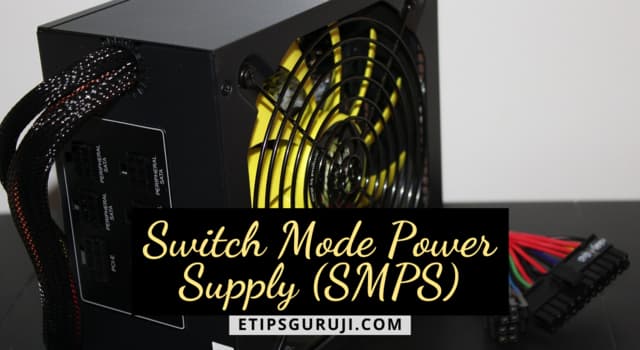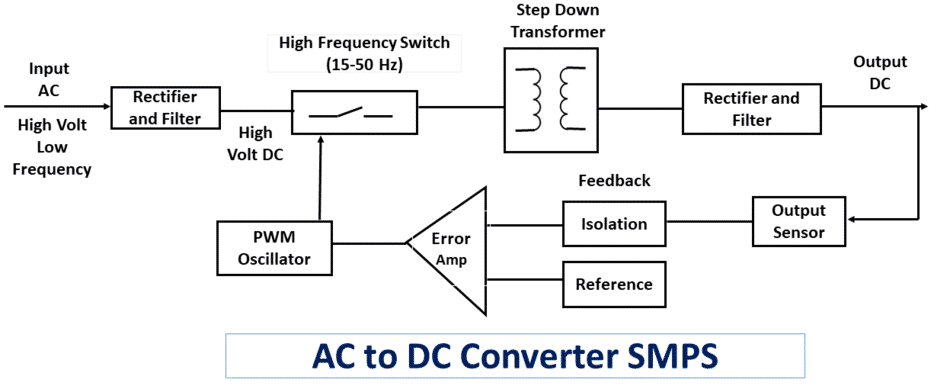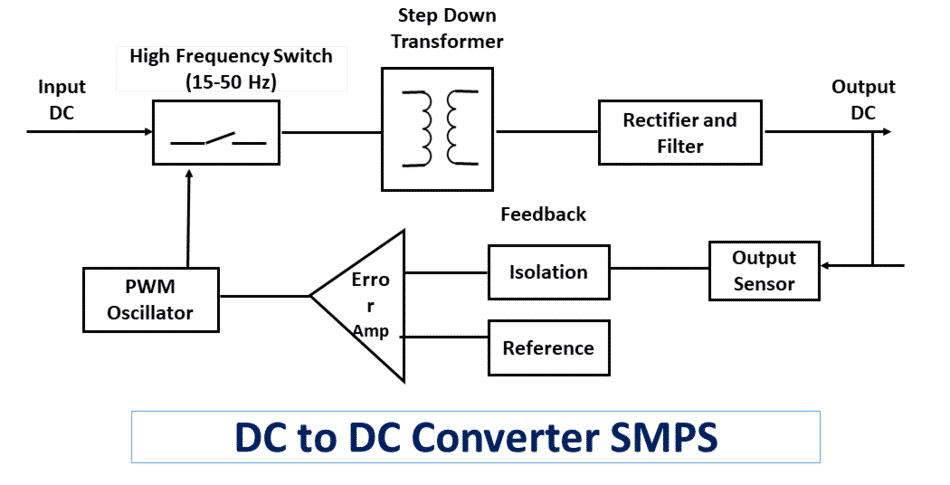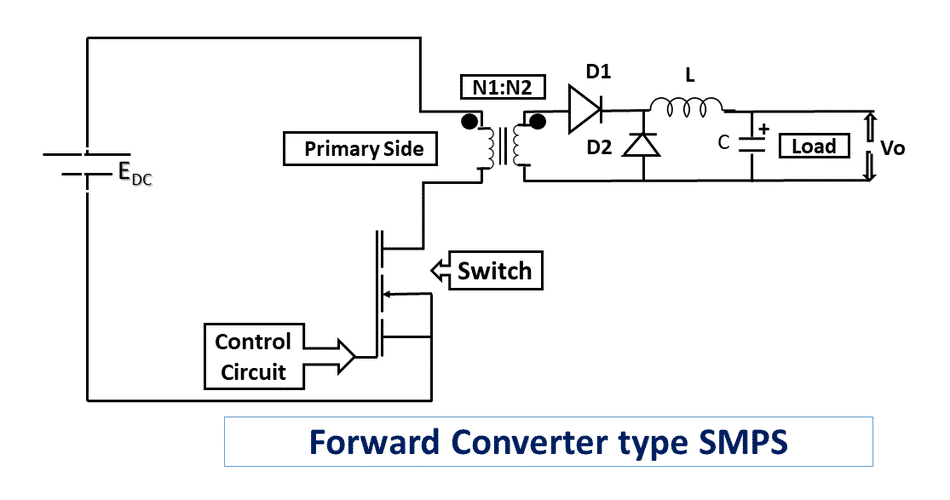Switch Mode Power Supply (SMPS) – Function, Types, Merits

Switch Mode Power Supply (SMPS) is a type of special electrical equipment that is used to supply power to almost all of our home and office electronic devices, including our personal computers (PCs), mobiles, battery chargers, TVs, and vehicles.
So, in this post, you are going to get all the details related to Switch Mode Power Supply (SMPS) along with its type, function, working, application, pros, cons as well as some frequently asked questions.
What is a Switch Mode Power Supply?

A Switch mode power supply (SMPS) is nothing but an electronic power circuit converter that converts electrical power using a switching device from one form to another. These electronic devices include a combination of diodes and MOSFETs such as inductors, capacitors, and semiconductor devices.
In general means, an SMPS converts irregular AC or DC voltage into regulated DC voltage using switching frequencies. While talking about its other name, it is also called to be Switching Mode Power Supply, Switched Power Supply, or Switcher.
As stated earlier, an SMPS is used to supply power in almost all our household electronic devices. In addition, they are used in various electronic devices such as personal computers and other sensitive devices to supply continuous and adequate power supply.
Quick Fact About SMPS
- It mainly works to supply power to start circuitry electronic devices.
- In general, it converts a wall-voltage AC power to lower voltage DC power.
- Despite the difference in voltage, it regulates electric power and provides reliable and consistent output.
- Inside the computer, different components require different amounts of electric power. In that case, a Switch Mode Power Supply provides power to each part as per its requirement.
People Also Read:
- Types of Transformer (Categories Wise) – Working and their Applications
- MOSFET Transistor: Basics, Working Principle, 2 Types & Uses
- Digital Voltmeter- Principle, 4 Basic Types, Applications, Merits & Demerits
What is the main Function of SMPS?
High-frequency switching devices transform power in a switched-mode power supply (SMPS), which is an electrical circuit. Switching components, like inductors or capacitors that provide power when the switching is in its non-conduction state, are also storage components.
High-efficiency switching power supplies are widely used in a variety of electronic equipment, such as computers and other delicate devices necessitating a reliable and efficient power supply.
When referring to a switch-mode power supply, the term switching-mode power supply is also used.
Function of SMPS in Computer
Switch-mode power supply – SMPS function or duty is to reduce the voltage of wall-voltage AC power to a lower level of DC electricity for use in electronic devices. 1.2-3.3V DC power is required by the majority of current computer chips, but 5-12V DC power is required by a small number of older systems.
Linear power supply, which employed massive transformers and linear regulators and dissipated much of the surplus energy as waste heat, were prevalent in the early days of personal computers. Modern SMPS systems, on the other hand, may achieve efficiencies of 90 percent or greater and in a considerably smaller packaging than these older devices.
By breaking the circuit, the SMPS leverages the reverse voltage spike from the collapse of the magnetic field to store the energy in a lower-voltage capacitor. To keep the required DC voltage at the output constant, a feedback circuit changes the switching rate according to the amount of current flowing through it.
A buck converter is what we’re talking about here. A boost converter, which is utilised when the input voltage is less than the required output voltage, is created by making just minor changes to the circuit.
This is how SMPS works in Computer.
Now, the next section is about Switch Mode Power Supply Block Diagram and its Explanation.
Types of Switch Mode Power Supply (SMPS)
There are basically four types of switching power supplies that are categorized on supply, input, and output voltages. These are
- AC to DC Converter SMPS
- DC to DC Converter SMPS
- Fly-back Converter SMPS
- Forward Converter SMPS
AC to DC Converter SMPS
In this type of SMPS, the input is AC and the output is DC.
Let’s take an example to illustrate what this means. The electricity coming into our homes is an alternating current (AC). But sensitive equipment such as computers requires a stable and efficient power supply that uses static energy called Direct Current (DC).
Therefore, an AC to DC Converter SMPS is required.
Working of AC to DC Converter SMPS

In this process, firstly the AC power is induced into the Switch mode power supply with the help of a wire. After that, the NTC thermistor with the help of the fuse, line filter, and capacitor stabilizes the power and gives it to the rectifier and filter. And this rectifier and filter convert it from AC to DC.
The block diagram for AC to DC converter SMPS
Meanwhile, the switching operation is completed with the help of the MOSFET amplifier. These special MOSFET transistors are designed to resist the high current. Moreover, the frequency is set and action of switching is controlled by feedback controller with the help of other special integral devices called PWM oscillator.
In short, when the input AC current enters the SMPS, it goes through a mixture of rectifiers and filters that are the bases of AC to DC conversion.
DC to DC Converter SMPS
A DC to DC converter is an electromechanical or electrical device that converts one type i.e. direct current (DC) voltage into another level of direct current (DC) and it is also a type of the electric power converter.
These DC to Dc converter SMPS are generally useful in portable devices such as mobile phones, laptop, and iPad, etc. which supplied power from the battery. They are also used in harvesting the energy from wind turbines and saving them into the batteries.
Working of DC to DC Converter SMPS

The input and output voltages are of DC types but the source and output are differed by the extent of voltage power. In general, the higher input power is used which ranges from 5kHz to 15kHz.
After that, the AC voltage goes through a step-down transformer which then induces the current into a rectifier and which finally used as the power supply for the input devices. However, this switch mode power supply also uses Pulse Width Modulation (PWM) to regulate the output voltage.
Fly-Back Converter SMPS
In this type of Switch Mode Power Supply, the output power is very low (less than 100W) irrespective of the input voltage. They have a simpler circuit and due to low output voltage, they are generally used in low power requirements or their integral equipment.
Working of Fly-Back Converter SMPS

When the current is induces in the fly-back converter SMPS, it passes through fast switching MOSFET that changed the input power into required output power. Moreover, a MOSFET transistor used to provide a consistent output voltage with a switching frequency of 100 kHz.
In fly-back converter SMPS, they use two windings which act as magnetically coupled indicators. These transformers winding helps in decreasing the power voltage value of the input power voltages. So, in short, you can say that they have a step-down transformer as an integral part.
After that, the voltages from the transformer goes through the capacitor and diode for both filtering and rectifying the required output power value.
Forward Converter SMPS
Conversely, Forward Converter Switch Mode Power Supply works similarly like a fly-back converter SMPS. But the key difference is, in forward SMPS uses different switching control devices which are called the DC-DC buck converter.
In general, it is used for generating a required and isolated output DC voltage from an unregulated DC input source.
Working of Forward Converter SMPS

A forward converter SMPS uses a DC voltage source which then passes through the integral transformer to serve the galvanic isolation of the input DC voltages. Additionally, this transformer generally serves two functions i.e. first is to scalation and the other is the isolation of input current.
Moreover, both the capacitor and the diode have an integral inductor that is connected to the output. So, if the switch is ON, the input goes through the primary winding of the transformer.
Key Parts of Switch Mode Power Supply
Some of the key parts and functions inside a Switch Mode Power Supply:
Rectifier: This part converts AC power to DC, which we call diode.
Capacitor: It filters unregulated DCs that are converted by rectifiers and converts them to smooth DCs.
Transformer: A transformer controls the incoming voltage by up and down.
Voltage Regulator: It controls the DC output so that the right amount of power, volts, and watts can be given to the computer hardware.
Heat Sink: It absorbs heat when the transistor is heated.
Fuse: This protects the circuit from heavy voltage.
Transistor: Its job is to switch the power.
Choke Coil: It works to smooth the received DC current.
So now let’s talk about its applications, advantages, and disadvantages, one by one to know more about the Switch mode power supply.
Application of Switch Mode Power Supply (SMPS)
The following are some applications of the Switch mode power supply:
- The switch-mode power supply is used in various electronic equipment such as in personal computers.
- It is used in machine tool industries.
- The Switch mode power supply is also seen in the security system such as powering the CCTV cameras.
- It is used in the railway system.
- They are also used in mobile and mobile equipment such as battery chargers.
- The Switch mode power supply is used in vehicles.
- It is also used in lighting and circuitry bulbs.
Advantages of Switch Mode Power Supply (SMPS)
The following are some advantages of Switched Mode Power Supply:
- It is small in size and has a lighter weight because of its high-frequency operation.
- The manufacturing cost is low due to the much smaller transformers used.
- It provides better power efficiency up to 60 to 70 percent than regulated linear power supplies
- SMPS is powerfully anti-interfering.
- SMPS has a wide range of outputs.
- It generates less amount of heat.
- The switch-mode power supply is less sensitive
- Provide isolation between multiple outputs
- Low power wastage
Disadvantages of Switch Mode Power Supply (SMPS)
The following are the disadvantages of the Switched Mode power supply:
- The design of the switched-mode power supply is more complex.
- Designing the circuitry board for an SMPS is a time-consuming process.
- The switch-mode power supply has high-frequency electrical noise.
- It can be used only as a step-down regulator.
- It has only an individual output voltage.
- SMPS is a source of both electromagnetic and radio interference due to the high-frequency switching speed.
- To control the radio frequency noise, additional filters are required on both input and output of SMPS.
- It is better to use a linear regulated power supply for a lower power output of 10 or less.
How to Test a Faulty PC SMPS?

With the following step, you can easily test whether the Switched-mode power supply functions correctly or not. Just simply follow the following pointers.
Step1. Turn off your computer and remove the screw that is present in the side panel of your computer.
Step 2. Remove the connection to the motherboard from the Switch mode power supply.
Step 3. Use a metallic paperclip and bend it in U shape.
Step 4. Locate the green and black wire from the SMPS wiring and select any one of the black wire from the bigger connector. Note, that there will be one green wire and many black wires. You can stick the metallic paper clip into the pins of the SMPS.
Step 5. Connect the Power cable and Power on the Switch mode power supply.
Step 6. If the switch mode power supply fan spin, then there is no issue with your PC SMPS.
Difference Between Linear Supply and Switch Mode Power Supply
These are some pointers that might help you understand the difference between Linear Supply and Switch Mode Power Supply.
Definition
In an SMPS, it first converts the input signal into AC/DC power and then steps down the voltage to the necessary level that is required by the powering equipment. On the other hand, linear supply firstly steps down the alternate current voltage and then converts it into Direct Current (DC).
Efficiency
Switch Mode Power Supply generally has a better or high efficiency which is about 60 to 70 percent. However, the linear supply efficiency rate is about 20 to 25 percent.
Voltage Regulation
In the Switch mode power supply, the voltage regulation is done by a feedback circuit, whereas in linear supply, voltage regulation is done by a voltage regulator.
Magnetic Material
In the Switch Mode Power Supply, generally, the ferrite core that has lower conductivity losses at high frequencies. Whereas, Cold Rolled Grain Oriented (CRGO) core is used for reducing the core losses in transformers.
Weight
The Step-Down transformer which is used in SMPS is less bulky as compared to linear supply.
Reliability and Complexity
The switch-mode power supply is more complex and less reliable, whereas, linear supply is more reliable and less complex.
Applications
In linear supply, audio frequency and RF applications are used. While in SMPS, it is used in chargers of DC motors, mobile phones, and many more.
Noise Disturbance
In SMPS, noise disturbance is more because of the switching action which makes it inappropriate for audio and radiofrequency applications. And, on the other hand, in the linear power supply, it creates a very stable environment with a very less noise disturbance for audio and radio applications.
Also Read:
- Step-Up Transformer: Principle, Application, Advantages & More
- Casing and Capping Wiring- 4 Basic Type & Installation Guide
Here our topic, Switch Mode Power Supply (SMPS) ends. Now, let’s have a look at some of the frequently asked questions that many users search on Google.
General FAQ
How many types of SMPS are there?
Mainly, there are 4 SMPS types – Switch Mode Power Supply
Can a power supply be repaired?
Yes, it can. But they are difficult to repair. And also after preparing the SMPS life cycle is not that much than the new one. So, we don’t recommend you to invest your money in repairing, instead, you should buy a new one.
What are some common problems of the PC Switch mode power supply?
Some PC related SMPS problems are the power don’t come on even after two-three tries, no beeps or alarming sign is observed, SMPS power supply on with beep and stops, prolong beeping sound, squealing sound from SMPS, and PC freezes- reboot suddenly.
Which is better between linear power supply or switching power supply?
It depends on the device because different equipment requires a different type of input voltages. And some applications such as linear power supplies are very useful in audio and radiofrequency equipment while a switching-mode supply is a handy tool for small equipment such as charger, etc.
Why do we need a power supply?
For the general-purpose, a power supply is an equipment that is used to convert AC to DC and most of the circuitry equipment works on the DC current even our phone. That’s the reason why we need a power supply.
Can a transistor converts DC to AC?
It depends upon the transistor itself which simply means a single transistor cannot convert direct current into an alternating current. But if you use more than one transistor with two capacitors then it might be possible that it can change direct current into alternating current. This circuit is known as a half-bridge inverter circuit.
What is a switching power supply 12v?
Switching power supply 12v is the most commonly used SMPS that can use in converting the various voltages of AC into 12V DC. This is accomplished by the use of a mixture of diodes, transistors, and transformers and broadly subdivided into 12V regulated power supplies and 12V unregulated power supplies.
